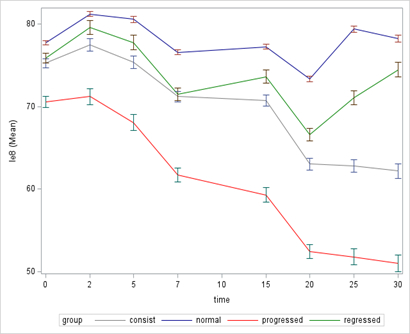Final ID: MP39
Life Essential 8 Is Associated with A Lower Risk Of Progression To Type 2 Diabetes
Abstract Body: Introduction:
The rising incidence type 2 diabetes (T2D) in young adults is linked with an increased risk of premature cardiovascular disease (CVD). Little is known about the association between cardiovascular health (CVH) metrics (Life Essential [LE] 8) and the risk of progression to T2D among at-risk young adults.
Objective:
We aimed to characterize LE8 trajectories by glycemic status change and examine the association between LE8 categories and T2D progression risk in young adults with prediabetes (preDM).
Methods:
The CARDIA (Coronary Artery Risk Development in Young Adults) Year 7 to Year 30 data were used. We identified participants with preDM (fasting glucose [FG] 100-125 mg/dL or HbA1c 5.7% to 6.5% when available, in each visit). The risk of progression was defined by any T2D indication (FG≥126 mg/dL or HbA1c >6.5%, a T2D diagnosis, or use of anti-diabetes medication) in the following visits among those preDM. We also identified other glycemic change categories, including 1) consistent preDM (remain preDM from identification to follow-up visits); 2) regression (preDM who reverted to normoglycemia during follow-up); 3) euglycemia (normoglycemia throughout).
LE8 scores included: diet, physical activity (PA), smoking, sleep, BMI, blood lipids, blood glucose, and blood pressure (BP). Each component was scored 0-100, creating a composite CVH score per AHA guidelines, categorized as ideal, moderate, or poor.
We used MANOVA to compare LE8 score trajectories across glycemic change categories, adjusting for age, race, and sex. Cox regression assessed the link between LE8 scores and progression risk, adjusted for age, race, and sex.
Results:
Among 1,242 participants with preDM, 26% progressed to T2D, 41% remained consistent preDM, and 33% regressed to euglycemia. Additionally, 2,736 participants had consistent euglycemia. Over 23 years, those who progressed to T2D had the greatest decline in LE8 scores (Figure 1). Adjusted Cox regression revealed that ideal and moderate LE8 significantly reduced the risk of T2D progression (Hazard Ratio 0.081 95% CI 0.037-0.179, P=0, and 0.467,0.357-0.612, P=0, respectively). Similarly, ideal or moderate PA, Lipids, BMI, BP, and glucose scores were associated with reduced risk of progression.
Conclusions:
Ideal CVH metrics are associated with reduced risk of progression to T2D among young adults with preDM. These results highlight the importance of cardiovascular risk control early in the course of dysglycemia to mitigate CVD risk.
The rising incidence type 2 diabetes (T2D) in young adults is linked with an increased risk of premature cardiovascular disease (CVD). Little is known about the association between cardiovascular health (CVH) metrics (Life Essential [LE] 8) and the risk of progression to T2D among at-risk young adults.
Objective:
We aimed to characterize LE8 trajectories by glycemic status change and examine the association between LE8 categories and T2D progression risk in young adults with prediabetes (preDM).
Methods:
The CARDIA (Coronary Artery Risk Development in Young Adults) Year 7 to Year 30 data were used. We identified participants with preDM (fasting glucose [FG] 100-125 mg/dL or HbA1c 5.7% to 6.5% when available, in each visit). The risk of progression was defined by any T2D indication (FG≥126 mg/dL or HbA1c >6.5%, a T2D diagnosis, or use of anti-diabetes medication) in the following visits among those preDM. We also identified other glycemic change categories, including 1) consistent preDM (remain preDM from identification to follow-up visits); 2) regression (preDM who reverted to normoglycemia during follow-up); 3) euglycemia (normoglycemia throughout).
LE8 scores included: diet, physical activity (PA), smoking, sleep, BMI, blood lipids, blood glucose, and blood pressure (BP). Each component was scored 0-100, creating a composite CVH score per AHA guidelines, categorized as ideal, moderate, or poor.
We used MANOVA to compare LE8 score trajectories across glycemic change categories, adjusting for age, race, and sex. Cox regression assessed the link between LE8 scores and progression risk, adjusted for age, race, and sex.
Results:
Among 1,242 participants with preDM, 26% progressed to T2D, 41% remained consistent preDM, and 33% regressed to euglycemia. Additionally, 2,736 participants had consistent euglycemia. Over 23 years, those who progressed to T2D had the greatest decline in LE8 scores (Figure 1). Adjusted Cox regression revealed that ideal and moderate LE8 significantly reduced the risk of T2D progression (Hazard Ratio 0.081 95% CI 0.037-0.179, P=0, and 0.467,0.357-0.612, P=0, respectively). Similarly, ideal or moderate PA, Lipids, BMI, BP, and glucose scores were associated with reduced risk of progression.
Conclusions:
Ideal CVH metrics are associated with reduced risk of progression to T2D among young adults with preDM. These results highlight the importance of cardiovascular risk control early in the course of dysglycemia to mitigate CVD risk.
More abstracts on this topic:
A multi-proteomic Risk Score Predicts Adverse Cardiovascular Outcomes in Patients with Angina and Non-obstructive Coronary Artery Disease
Huang Jingwen, Lodhi Rafia, Lodhi Saleha, Eldaidamouni Ahmed, Hritani Wesam, Hasan Muhammet, Haroun Nisreen, Quyyumi Arshed, Mehta Puja, Leon Ana, Ko Yi-an, Yang Huiying, Medina-inojosa Jose, Ahmed Taha, Harris Kristen, Alkhoder Ayman, Al Kasem Mahmoud
Acetylation of Electron Transfer Flavoprotein Alpha Is a Possible Regulatory Mechanism of Fatty Acid Oxidation in Diabetic HeartsTatekoshi Yuki, Yano Masaki, Hosoda Ryusuke, Saga Yukika, Kuno Atsushi

